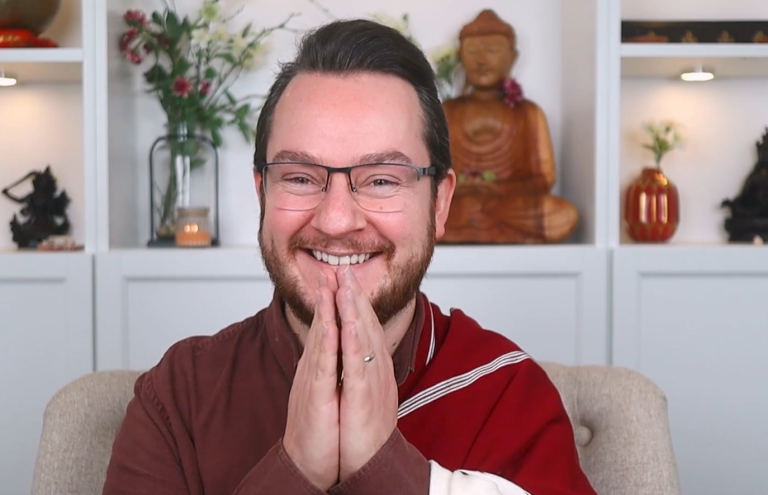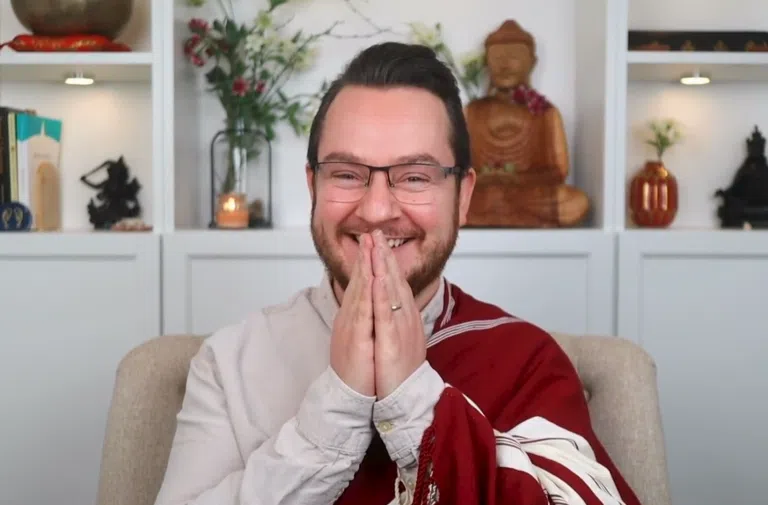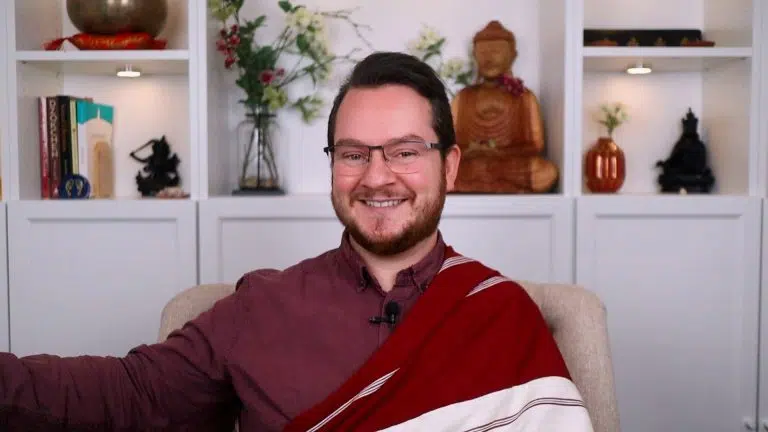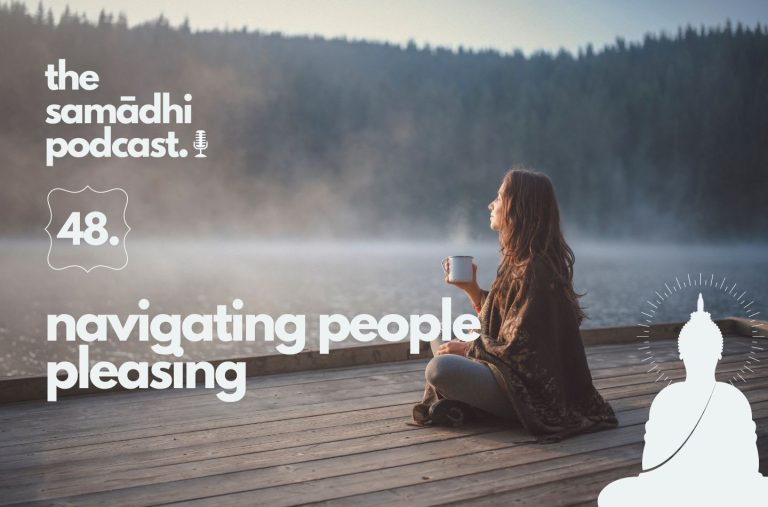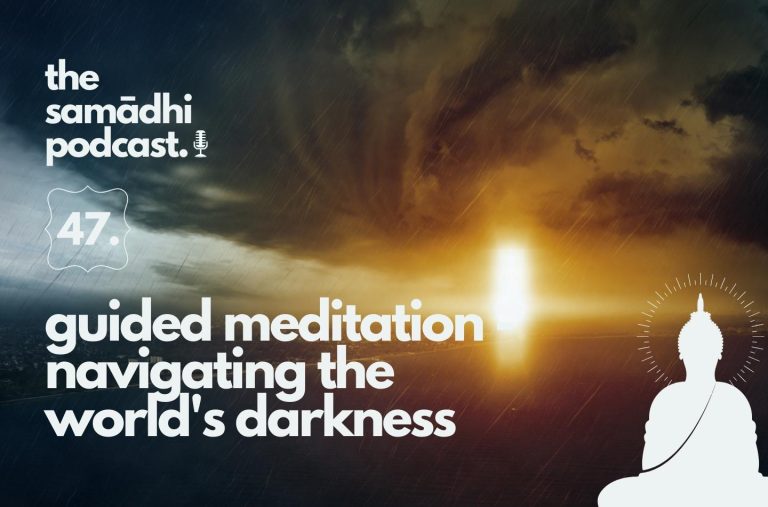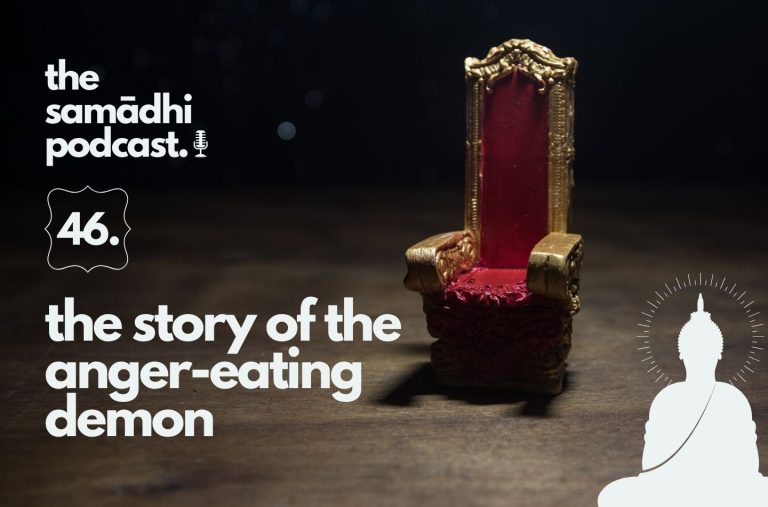SUNDAY 9 JANUARY 2022 – MAKING MEDITATION A SIMPLE PRIORITY
Good morning everyone, hello, welcome, namaste, buenos dias. So I hope everyone is happy and well. I hope you’ve had a restful couple of weeks. I’m delighted to see so many here, regulars, new people. I can see some faces from retreats as well. So just as a reminder of the format, if you haven’t been to one of these sessions before, we go straight into our meditation then (sorry, just letting somebody in), we go straight into our meditation then I give a bit of a talk, a bit of a something for us to focus on for the week and then we go into our open discussion so if you haven’t done already, please take a moment to find somewhere quiet, somewhere comfortable where you won’t be disturbed and we’ll go straight into our meditation.
(Bell rings)
As we begin our meditation, I’d like to recap the appropriate posture for meditation and there are several options open to you. I would recommend either sitting cross-legged on a cushion, if you can, or sitting on a chair but if that is uncomfortable, you can assume the savasana, laying flat on your back. Savasana can be very wonderful for relaxation but for many it leads to feeling drowsy or sleepy so if that happens, change to a seated posture. Whatever posture you choose, do what you need to do to be comfortable. Don’t be afraid to use extra cushions for support. It’s important for your back to be naturally upright and that’s a straight back but relaxed at the same time, not rigid, with your shoulders level. Then tilt your head ever so slightly forward, let your tongue rest lightly against the roof of your mouth, just behind your teeth and if it’s comfortable you can let your eyes remain lightly open or you can close them. Your arms should be not tight against the body but relaxed, leaving some space in the armpit, and then just rest your hands comfortably in your lap. Breathe naturally through the nose and let’s just take a few breaths and see how it feels to sit like this with nothing to do, nowhere to go.
Then let’s take some time to bring ourselves into the body. We can allow our awareness to come down from the head down into the body, right down to the ground, noticing that contact with the ground, what we call the earth element. We don’t need to visualise that contact with our cushion or the chair, the floor. Simply become aware of the tactile sensations there. Then let your awareness rise up and fill up the entire space of the body, illuminating all tactile sensations at once. Set the body at ease, give yourself permission to relax. It might help to take a deep breath in here, allowing the belly and chest to expand and fully release. Bring your awareness back up to the top of your head and slowly work from the top of your head down, noticing any areas of tension or tightness in your face, your neck, releasing any tension with the out-breath, letting all areas of the face, the jaw, the eyes feel soft. Moving on to the shoulders, the back and the chest and notice how your arms and hands feel and then extending your awareness once again through the lower body, the hips, the legs and the feet. If you feel you want to adjust your position at this time, feel free to do so. It can help to gently rock yourself side to side, just to get yourself comfortable in the right place. And when you feel you are comfortable, commit to remaining as still as possible for the rest of the meditation.
Take a little time to just sit and breathe, feel the breath as it enters your body, how it fills your lungs then feel it again as you exhale, leaving the body. Notice the natural rise and fall, the ebb and flow, the receiving and the letting go. Let the breath be natural, there’s no need to force it, just let it find its own rhythm. If you find your mind wandering, that’s completely fine and it’s natural. So when you notice, I want you to let yourself relax just a little bit more with the out-breath and then very gently return your mind to the in and the out-flow of the breath. Feel the sense of stability in your posture, you’re sitting unmoved like a mountain on the earth. At the same time there’s a sense of lightness and freedom in the upper body. Let’s sit like this now for a few moments, relaxed, straight back, being aware of the breath flowing into the body and flowing out again, like the waves lapping up on the shore and retreating out again, letting the breath be as it wants to be.
To help your focus, you can count these next seven breaths. Very simply count one at the end of the exhale and two at the end of the next exhale, all the way to seven. If you get distracted, don’t worry. When you realise you are distracted, you can just start again from one. Remember natural breathing through the nose, being aware of the body rising as you inhale, falling as you exhale. If you found the counting helpful, continue to count again, one to seven. If you notice any feelings of restlessness, tension, give yourself permission to relax, to be here, nothing to do, nowhere to go. Everything else can wait. We can release our focus of the breath for now, bring ourselves back to the body, become aware of your body again. How does it feel? Is it more relaxed? Is it more tense? What do you notice now about the mind and body? Be careful not to judge, meditation is not about expectation, it’s not about getting somewhere or being someone different, it’s about becoming aware. We can relax our concentration and bring our practice to a close.
(Bell rings)
Excuse the interruption from the mindless robot at the end!
So this morning, I wanted to chat a little bit about the importance of meditation as part of our life cause meditation is often talked about as a method to relax, you know, de-stress but I find it so much more than that, you know, I think some sort of meditation practice is essential to keeping a healthy balanced mind. There’s a lot that we’re encouraged to do in order to look after this body, eating well, brushing our teeth, washing our hair, taking vitamins or whatever, these things we do to take care of the body but we’re not just masses of skin, bone, organs and so on. We also have a mind and our mind needs looking after as well. So we could compare a five or ten minute meditation every day to being as essential as brushing your teeth. Brushing our teeth is dental hygiene, making sure they don’t fall out, looking after them, making sure we’ll have them, they’re the only pair we have. My teacher likes to call a short daily meditation as like psychological hygiene. It won’t get you all the way to enlightenment but it’s psychological hygiene, it keeps the mind healthy, keeps the mind rested, focussed. So I like to think of meditation as not just the paracetamol for the headache, not just the quick fix for the disturbed mind but it’s also preventative. It stops those imbalances happening in the first place. The analogy my teacher gave is of cleaning up our environment, you know the effect that humans are having on the planet. Yes, we need to clean up, clean up our act, remove the junk we’ve been polluting the planet with, clean up after ourselves but we also need to stop polluting in the first place, stop mass deforestation in the first place. Same thing, meditation is just like this, it’s cultivating a balanced healthy mind, preventing the imbalances of the mind. You get the most out of meditation when you do this, not when it’s just panic meditation, you know, you’re having a really stressful time, I’ve heard this term quite a bit recently, ‘panic meditation.’ It’s best when it’s also preventative, when it’s part of your regular habit.
Now, I think one thing that prevents many people from practising regularly is that meditation becomes too complicated or it becomes like a chore, you know, perhaps we see meditation on our own as too difficult to do or it’s boring or we don’t see the value of it and in that case I think sometimes what happens is meditation becomes too complex. We start, or maybe we’re pushing too hard or expecting too much so we can look at it from another angle. Let’s say that you are in your garden or you’re on a park bench, or you’re just sat at home next to an open window and it’s a fresh sunny day, not like it is here in Wales right now, and you’re just sitting quietly. It’s not particularly exciting but you’re still getting pleasure from just having that quiet moment to relax, enjoying time away from work and responsibilities, even though you’re not really stimulated or doing anything. Then imagine that instead of keeping your eyes open, you decide to close your eyes. You can still hear everything outside, the sound of the wind, nature, people talking, vehicles in the distance. You’re aware that they’re out there and now and again a random thought comes up, maybe it’s funny, sometimes interesting, sometimes creates worry or fear but if you focus again, you can just become aware of those various sounds around you again.
Meditation can be just that. In that example, the object of meditation is sounds, you’re practising mindfulness of sound. You allow yourself to just be aware of whatever sound comes up and when you get lost in your own thoughts or thinking about sound, you know, ‘How big is that dog I can hear? Is it the neighbour’s dog? Is it someone…’ You know, we get lost in that thinking about it, instead of just fighting or resisting the thought, we can just leave it behind and come back to being open to all sounds again. Nothing more to do than just rest in stillness, enjoy that moment of calm. You can do that sort of simple meditation with anything, something you can see in front of you or a tactile sensation like the breath.
So we can simplify our meditation, if we think it’s become too difficult or it’s a chore or ‘I’m not sure I can fit that into my life.’ Make it something very simple. Meditation also is not just some static thing, you know, if we look at meditation as this term bhavana in Pali which means ‘to cultivate’ or in Tibetan the term is gom which means ‘to familiarise’. That’s our real meditation practice, this is a way of just cultivating and familiarising the mind, all the time. This is attending to your mind, minute by minute, being watchful of what’s going on, noticing the arising of attachment, aversion, deluded pride, envy and doing what we can to avert it, you know, applying the opponents, training our mind, familiarising our mind instead with positive states, with patience, compassion.
So if you don’t feel like meditation was a strong enough part of your 2021, I’d say let’s make that determination now, that 2022 is going to be a year where meditation becomes a part of our life. I am going to care for my mind because if I don’t, who will? My peace of mind, my enjoyment of life, my ability to remain calm and resilient when I face difficulties, these are important to me. I must care for my mind.
That’s what I wanted to share this morning. Just before we go into our discussion, I have a couple of announcements I wanted to mention. First is the podcast. I finally recorded a couple more podcasts. They got uploaded a couple of days ago so if you haven’t listened before, now might be a good time to start listening. I’ll be uploading a few, I’ve had some requests so I’ll be uploading in the coming weeks. That’s called The Samadhi Podcast, you can find that on our website or if you search it on Spotify, Apple Podcasts and so on. Second thing is I’m adding an additional free weekly meditation, this is on Tuesdays at 10am and this is simply a shamatha practice. I’ll just briefly explain what practise we’re doing, we’ll do the practice and then if anybody has any questions about their practice, that’s, er, I’ll answer. There’s not so much of a discussion part so if you’re free on Tuesdays, please do join us for that. Then third thing is I’m going to be doing a Refuge Vow Ceremony in a couple of weeks’ time, probably the Saturday, 22nd or Sunday 23rd. Going for refuge is, when we’re determined, when we’ve got some confidence in meditation and some confidence in what the Buddha’s teaching and we feel like ‘yes, I am done with this suffering thing, I want to feel better, I want to cultivate my mind, transform my mind’ and we want to make that determination, the Refuge Vow is a good way to do that so I’d love if you wanted to join us for that. Feel free to send any questions you have about that. You can find that on our website as well, I think.
Transcript by: Laura Maisey

